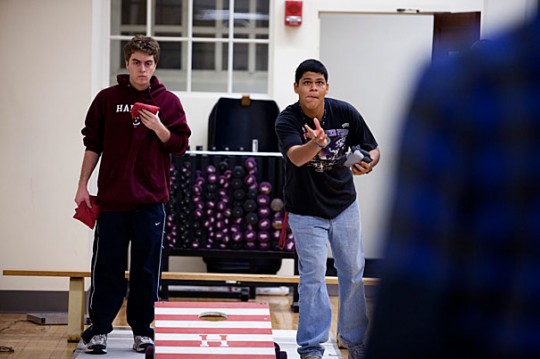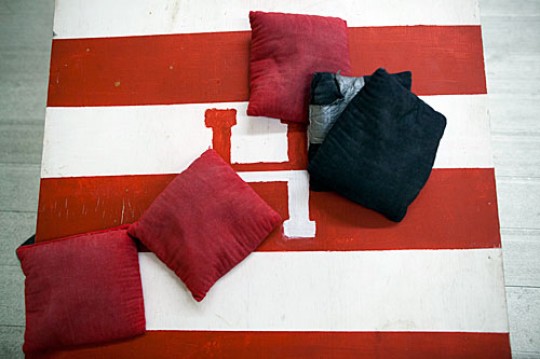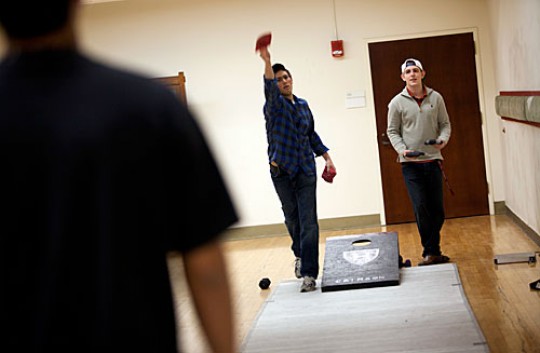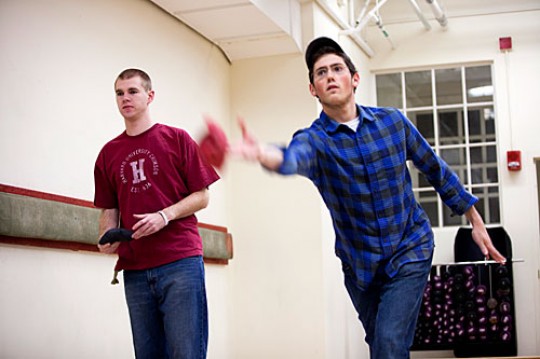The magic of beanbags
The magic of beanbags
High school friends bring their game to Harvard
 David Mazza ’14 (left) and Juan Favela ’14 toss around some beanbags at a Monday practice of Harvard’s cornhole club.
David Mazza ’14 (left) and Juan Favela ’14 toss around some beanbags at a Monday practice of Harvard’s cornhole club.
The summer before they started at Harvard, high school friends Joe McCormick and Jamie Dickerson drove to Home Depot to buy plywood. “We decided to build cornhole boards,” recalled McCormick, now a sophomore and an engineering sciences concentrator.
Cornhole, also known as beanbag toss, at its simplest involves two to four players throwing beanbags through holes fashioned into opposite-facing slanted boards. Using guidelines provided by the American Cornhole Association (ACA), McCormick said, “We spent a night building this board to ACA specs, and my sister sewed together bags with sand and some sort of pink beans we found at the grocery store.”
The two played all summer in their hometown of Melrose, Mass., painted the boards with the Harvard seal, and brought them to campus to start their freshman year.
They began researching how to start a Harvard club sport. But paperwork issues befell them freshman year, so the unused boards were put to utilitarian use: The slanted end was propped on a stool to form a makeshift coffee table, and the hole was sized perfectly to hold a bowl of snacks.
Cornhole debuted as an official club sport last spring, with McCormick as president.
 “We spent a night building this board to ACA specs, and my sister sewed together bags with sand and some sort of pink beans we found at the grocery store,” said club president Joe McCormick ’14.
“We spent a night building this board to ACA specs, and my sister sewed together bags with sand and some sort of pink beans we found at the grocery store,” said club president Joe McCormick ’14.
“What’s great about the sport is that it’s really easy to pick up, and it’s really relaxing,” said club member and applied math concentrator Harry Chiel ’14. “I think the relaxing point is one of the reasons we play. You can be enjoying the nice day outside and doing a fun activity that is somewhat competitive and fun but also doesn’t require a lot out of you.”
The club practices Monday nights in the Malkin Athletic Center. “We’ve had a varied turnout, but we’re hoping to expand and get the word of cornhole out in the Harvard community,” said Dickerson, a government concentrator.
 “We’re hoping to expand and get the word of cornhole out in the Harvard community,” said Jamie Dickerson ’14 (right). On the left is Harry Chiel ’14.
“We’re hoping to expand and get the word of cornhole out in the Harvard community,” said Jamie Dickerson ’14 (right). On the left is Harry Chiel ’14.
One of the ways the club is improving visibility is by doing charity events. “We partnered with Relay for Life and did an event in front of the Science Center called ‘Cornhole for Cancer,’ ” said McCormick.
“We’re planning to do a big tournament, have a lot of people enter, and use the money for Joe’s charity,” said club member and economics concentrator David Mazza ’14.
McCormick is legally blind because of an ocular disease called Leber’s hereditary optic neuropathy. “My disease is very rare, only 100 cases a year, so we’re hoping to raise money for research efforts,” he said.
 “We don’t play anyone else because there’s no other collegiate cornhole groups around here,” said club president Joe McCormick ’14 (left). “We’ve been trying to work out what we want to do besides play for fun. Right now we’ll just play a game, play a game, play a game, and switch teams.”
“We don’t play anyone else because there’s no other collegiate cornhole groups around here,” said club president Joe McCormick ’14 (left). “We’ve been trying to work out what we want to do besides play for fun. Right now we’ll just play a game, play a game, play a game, and switch teams.”
Armed with funding from Harvard, the club purchased new boards and bags from — where else — www.cornhole.com. The stark white boards are ready to be decorated and utilized.
“We don’t play anyone else because there’s no other collegiate cornhole groups around here,” said McCormick. “We’ve been trying to work out what we want to do besides play for fun. Right now we’ll just play a game, play a game, play a game, and switch teams.”
But with these guys advocating the sport, the future of the cornhole club looks promising.
“A couple freshmen came earlier this year, and they seem to like it a lot, so if we get more kids who really enjoy it, they can stick with it after we graduate,” said Mazza.
“Cornhole combines elements from traditional sports, and even board games,” said Dickerson. The winner of cornhole is the first to reach 21 points. But scoring is quite complex. A bag on the board is one point, and a bag in the hole is three points. However, if both teams have a bag on the board, or a bag in the hole, they cancel each other’s points.
“There’s a lot of strategy because you can’t go over 21 points, so it’s a thinking game as well as an active game,” said Dickerson.
“It’s kind of like a carnival game. You’re throwing a beanbag through a small hole, and that’s attractive to people,” said Chiel.
“And because of the scoring, some games can go back and forth, back and forth,” added McCormick.
Echoed Chiel: “It can get pretty dramatic.”
By Sarah Sweeney
Harvard Staff Writer
Photos by Stephanie Mitchell/Harvard Staff Photographer
###
About Harvard University.
Established in 1636, Harvard is the oldest institution of higher education in the United States. The University, which is based in Cambridge and Boston, Massachusetts, has an enrollment of over 20,000 degree candidates, including undergraduate, graduate, and professional students. Harvard has more than 360,000 alumni around the world.
Harvard University is devoted to excellence in teaching, learning, and research, and to developing leaders in many disciplines who make a difference globally. Harvard faculty are engaged with teaching and research to push the boundaries of human knowledge. For students who are excited to investigate the biggest issues of the 21st century, Harvard offers an unparalleled student experience and a generous financial aid program, with over $160 million awarded to more than 60% of our undergraduate students. The University has twelve degree-granting Schools in addition to the Radcliffe Institute for Advanced Study, offering a truly global education.
‘Universities nurture the hopes of the world: in solving challenges that cross borders; in unlocking and harnessing new knowledge; in building cultural and political understanding; and in modeling environments that promote dialogue and debate… The ideal and breadth of liberal education that embraces the humanities and arts as well as the social and natural sciences is at the core of Harvard’s philosophy. ’/ Drew Gilpin Faust
More About Harvard University & About Harvard University. Information.
###
* The above story is adapted from materials provided by Harvard University
_________________________________________________________________




















